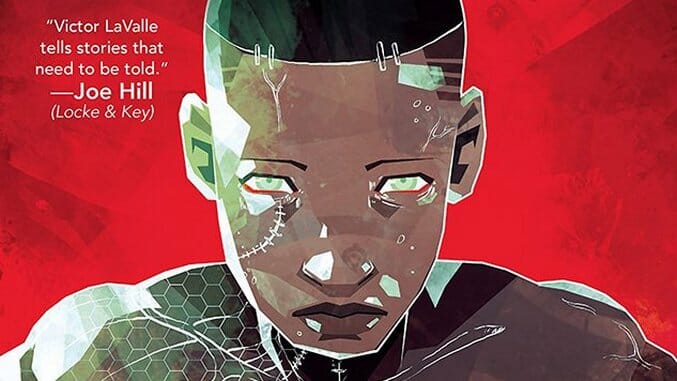Victor LaValle Resurrects Frankenstein in Socially Conscious New Comic, Destroyer
Main Art by Micaela Dawn
Author Victor LaValle abounds with monsters. His novel Big Machine chronicles the actions of a secret society investigating mysterious creatures that defy logic, while his acclaimed novella The Ballad of Black Tom riffs on the cosmic horror of H.P. Lovecraft as it critiques the racism that frequently appears in the horror icon’s oeuvre. It’s no suprirse that LaValle’s latest project, a collaboration with artist Dietrich Smith, finds a unique take on one of the most classic monsters of all.
With his new project, Destroyer, LaValle joins the ranks of writers with one foot in prose and the other in comics. (See also: G. Willow Wilson, Joe Hill, Mat Johnson and Samuel Sattin.) The comic, whose first issue debuts this week via BOOM! Studios, offers a new update on Mary Shelley’s classic goth icon—in the opening scene, a whaling vessel ends the centuries-long isolation of Frankenstein’s Monster from society. But it also swerves into the modern friction of race, police violence and identity, as a brilliant scientist, Dr. Baker, attempts to resurrect her fallen son through future-forward technology.
Paste emailed with LaValle to learn more about the origins of Destroyer and the themes that appealed to him the most. ![]()
Paste: A lot of your recent fiction has also explored questions of horror and what makes a monster a monster. What makes the story in Destroyer best suited to comics rather than to prose?
Victor LaValle: This time around I thought we could do a lot more with the monsters, things that just couldn’t be done with prose. In particular, I wanted to offer a pretty different take from what’s become the more usual Frankenstein’s Monster image. Of course, Boris Karloff’s version has had an enduring appeal, but then there have been the slightly more human-looking ones. I’m thinking of that I, Frankenstein movie. The great Bernie Wrightson came up with an all-time beauty long ago. In my case I told the artist who designed the creature—Dan Mora—that I wanted a creation that was a mix of Iggy Pop and Moses. And he did give me exactly that. It was the kind of thing I might spend 10 pages trying to describe, but one image of that bad boy and you get it. I wanted to see how much more we could do.

Victor LaValle’s Destroyer #1 Interior Art by Dietrich Smith and Joana LaFuente
Paste: In the first issue, you make it very clear that the Monster’s sense of morality doesn’t line up with human concepts of [morality]. What were some of the challenges of writing a character who interacts with the world in a somewhat alien way?
LaValle: I don’t think the Monster’s morality is all that alien. He’s a misanthrope. He hates humanity because he believes humanity kills everything that crosses its path. And I can’t say he’s wrong. Part of the thrill of writing his character was letting my most anti-human impulses fly free. We tend to think that if we have good intentions we should be absolved of the real-world harm we cause others. I didn’t mean for anything bad to happen! That kind of thing. But the Monster doesn’t give a shit about anyone’s reasons. He only sees our effects. And he’s had enough of us. He’d like to see every human being wiped from the face of the Earth because then the place might run a lot better. I’ll bet there are a fair number of human beings who think the same way.
Paste: At the same time, Dr. Baker’s reaction to grief and desire to make things right after the death of her son come from a very human, moral place. Do you see these potentially conflicting approaches to life as the central conflict of the book?
LaValle: Well, I’m glad Dr. Baker’s impulses seem more relatable. They do come from a place of grief. But even though her impulses are more understandable, that doesn’t mean the results will be any less wholesome than the Monster’s. She’s motivated by grief, but also by rage. She’s very angry about what happened to her son. And as a result, she’s vulnerable to the same impulse to do harm to the world. This was one of the things I wanted to explore: the distinction between our intent and our actions. How much slack does a good heart buy a person? And why do we cut others less slack if the results are much the same?
-

-

-

-

-

-

-

-

-

-

-

-

-

-

-

-

-

-

-

-

-

-

-

-

-

-

-

-

-

-

-

-

-

-

-

-

-

-

-

-












































